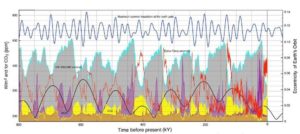
Ice cores from Antarctica and Greenland have provided enormous insight into Earth’s climate over the past 800,000 years; in 2017 a deeper ice core may soon provide additional information, dating back 2.7 million years. Ice cores are drilled in areas free of glaciers — meaning that snow has fallen and become compacted century after century. Ice cores reveal clues about past climate periods, specifically implications of global temperatures, combined with atmospheric CO2 and O2 levels (bubbles trapped in the ice).
From these ice cores we know Earth’s climate has been cyclical. Milankovitch cycles, named in honor of the 1920s discoverer, a Serbian physicist/astronomer, comprise Glacial Periods of about 100,000 years interspersed with Interglacial Periods of about 10,000 years; additional warming and cooling episodes occur, inside these two major Periods. What has remained a mystery — is why these cycles occur with relative regularity.
Milankovitch postulated these cycles are caused by variations in: precession (change in orientation of Earth’s rotational axis, relative to its previous rotational orientation — best exemplified by precession of a child’s spinning top); eccentricity (amount by which Earth’s orbit around the sun deviates from a perfect circle); and axial tilt (angle between Earth’s rotational axis and orbital axis). These three entities are also influenced by gravitational pull of other planets, especially Jupiter because of its large mass.
These three factors result in cyclical variation in amount of solar radiation reaching Earth’s north pole. When Earth is closest to the sun, one or the other hemisphere is facing the sun’s rays, which cause substantial effects on Earth’s climate (orbital forcing). Land mass of the northern hemisphere (68%) is twice that of the southern hemisphere (32%), as divided by the equator; thus, sun rays’ effects on the north pole are predominant. Milankovitch proposed that precession is the primary forcing agent that causes Glacial-Interglacial Period cycles.
A rough correlation of rising CO2 levels with increasing atmospheric temperatures — led to the “global warming” theory, which began in the late 1970s. Upon closer examination of the ice-core data, however, Ralph Ellis and Michael Palmer in their 2016 Geoscience Frontiers landmark paper, “Modulation of ice ages via precession and dust-albedo feedbacks,” pointed out that rising global temperatures precede increasing CO2 levels, on average, by an estimated five centuries [Figure 1].
 Figure 1: Temperature vs CO2 levels in Vostok (Antarctica) ice cores, from 50,000 to 2,500 years ago. °C (Y-axis, left) and ppm (Y-axis, right) are standardized to 0 °C and 280 ppm, respectively, corresponding to measurements from 2,500 years ago. Taken from JoanneNova.com.au. Global atmospheric CO2 levels today are ~410 ppm, of which estimates of contribution of human activity account for ~18 ppm (i.e. 4.4%) [https://edberry.com/blog/climate-physics/agw-hypothesis/the-death-of-climate-change/].
Figure 1: Temperature vs CO2 levels in Vostok (Antarctica) ice cores, from 50,000 to 2,500 years ago. °C (Y-axis, left) and ppm (Y-axis, right) are standardized to 0 °C and 280 ppm, respectively, corresponding to measurements from 2,500 years ago. Taken from JoanneNova.com.au. Global atmospheric CO2 levels today are ~410 ppm, of which estimates of contribution of human activity account for ~18 ppm (i.e. 4.4%) [https://edberry.com/blog/climate-physics/agw-hypothesis/the-death-of-climate-change/].
Intriguingly, presence of dust in the ice cores also occurs with periodicity, preceding the warming cycles [Figure 2]. Using radioisotope technology, scientists discovered that Patagonia (Argentina) is the dust source in Antarctica; Gobi (Mongolia) and Taklamakan (China) are the dust sources in Greenland. Moreover, increases in ice-core dust coincide with lowest CO2 levels (~180-200 ppm).
 Figure 2: Taken from Ellis & Palmer, Geosci Front Nov 2016; 7: 891–909. Summary graph (their Fig. 14) which includes all factors playing a role in glacial modulation. X-axis indicates Time before the present in thousands of years (kY), with left margin 800,000 years ago. Grey denotes relative Antarctic ice volume; red = European Project for Ice-Coring in Antarctia-3 (EPICA3) inferred global temperatures; yellow = CO2 levels; purple = EPICA3 dust levels; blue, at top = Milankovitch summer insolation at north pole; black = Earth’s eccentricity.
Figure 2: Taken from Ellis & Palmer, Geosci Front Nov 2016; 7: 891–909. Summary graph (their Fig. 14) which includes all factors playing a role in glacial modulation. X-axis indicates Time before the present in thousands of years (kY), with left margin 800,000 years ago. Grey denotes relative Antarctic ice volume; red = European Project for Ice-Coring in Antarctia-3 (EPICA3) inferred global temperatures; yellow = CO2 levels; purple = EPICA3 dust levels; blue, at top = Milankovitch summer insolation at north pole; black = Earth’s eccentricity.
Why would 500 years of dust, arising from these three high-desert regions, be periodically deposited in ice cores at either polar region? Not all desert regions produce dust having the appropriate grain size to be blown thousands of miles by sufficient wind-strengths; however, the Patagonia, Gobi and Taklamakan deserts contain “that perfect size.”
These polar dust storms for five centuries must be horrendous — far worse than dust storms seen in Phoenix. Or the 1930s “Dust Bowl” (precipitated by severe drought in the Midwest), which carried dust from Nebraska all the way to Washington DC.
How might five centuries of dust deposits in a polar region correlate with initiation of a warming period? The orbital cycle primarily responsible for Interglacial initiation is the precessional Great Summer — the result of largest increases in insolation (sun’s rays) in the northern hemisphere.
Not all warming cycles produce a Great Summer [Figure 2]; full Interglacials occur only once every four or five cycles. The important factor inducing a Great Summer is degree of decreased albedo (reflectivity) of polar ice sheets. In order for a Great Summer to occur, polar ice sheets need to be covered with a lot of dust; this will enhance absorption of sun’s rays, increasing heat — thereby resulting in a Great Summer event.
What causes these dust build-ups in a polar region? Colder oceans during Glacial Periods absorb more atmospheric CO2, essential for all plant life. Average biomass production of plants decreases about 50%, when grown at 180–220 ppm of CO2. Experiments show that 150 ppm of CO2 is near the threshold for successful photosynthesis in most species.
High-desert grasses are more vulnerable to low levels of CO2 than plants growing near sea level. When atmospheric CO2 levels fall below 200 ppm, the result is a die-back, especially of high altitude flora and widespread desert formation — resulting in dust storms and, subsequently, depositing of dust upon polar ice.
In summary, the forcing agents regulating Milankovitch cycles include Earth’s precession, eccentricity, and axial tilt. CO2 and dust levels are inversely correlated. Cooling during Glacial Periods leads to declining atmospheric CO2 levels, which causes a die-back of grasses in the Patagonia, Gobi and Taklamakan high deserts. This in turn results in about five centuries of severe dust storms, which cover polar ice fields. Reflectivity of sun’s rays off white snow is now changed to absorption of sun’s rays by dust-covered snow, causing heat. The result is an Interglacial Period of warmth, increased plant growth — and rising CO2 concentrations, originating from the warming oceans.
Following the warming period, polar ice reformation, and increases in sun’s reflectivity, again result in cooling of the oceans and climate. Diminishing temperatures lead to enhanced sequestration of atmospheric CO2 by the oceans — which, in turn, will bring about increased dust production in the high deserts. Because it takes ~70,000 years before ice-sheets become sufficiently large for temperatures and CO2 to reach a minima, this coincidentally places the increased dust-production era close to Earth’s next eccentricity minima.
The rate of ice-sheet regrowth plays a key role in determining the ~100,000-year length of a Glacial Period. If temperatures and CO2 have not reached their critical minimum values before onset of an eccentricity-enhanced Great Summer, substantial dust-ice-reflectivity feedback will not occur. One of the primary regulators of interglacial periodicity is the steady rate of increasing polar ice production. Thus, the planet waits patiently until the next enhanced Great Summer, when, hopefully, “all the participants in this performance” — between orbital forcing and climate feedbacks — are ready to “play their role.”
When sun’s rays are once again substantially reflected, rather than absorbed — combined with effects of precession, eccentricity and axial tilt — the next Glacial Period occurs. The Last Glacial Maximum peaked ~21,500 years ago, revealing massive regressions of forested areas in both hemispheres. It is comforting to know that we are currently in an Interglacial Period, and warming should continue for several thousand more years.
Why is the Ellis-Palmer paper so fascinating? First, Ellis conceived this explanation of Glacial-Interglacial Periods, as a ‘lowly’ graduate student! Second, this scenario is the best one yet, to explain Milankovich cycles. Third, this data-supported theory challenges the dire climate change predictions of human contributions of CO2 levels to the atmosphere — calculated only by incomplete and biased computer-modeling. Lastly, these data strongly contradict the proposal, presently being pushed by many wrongly influenced politicians, that “humankind needs a carbon tax to stop climate change.”
Daniel W Nebert is Environmental Sciences professor emeritus at University of Cincinnati. He is now semi–retired and lives with wife near Portland to be closer to the children and grandchildren. He thanks Drs. Will Happer and Ray D’Alonzo for offering helpful suggestions, and he appreciates all the interactions with Joe and Diane Bast, as they helped produce the fifth volume in the ‘Climate Change Reconsidered’ series, Climate Change Reconsidered II: Fossil Fuels — written by the Nongovernmental International Panel on Climate Change (NIPCC); this 768-page book was published in January 2019.
No Comments
Leave a comment Cancel